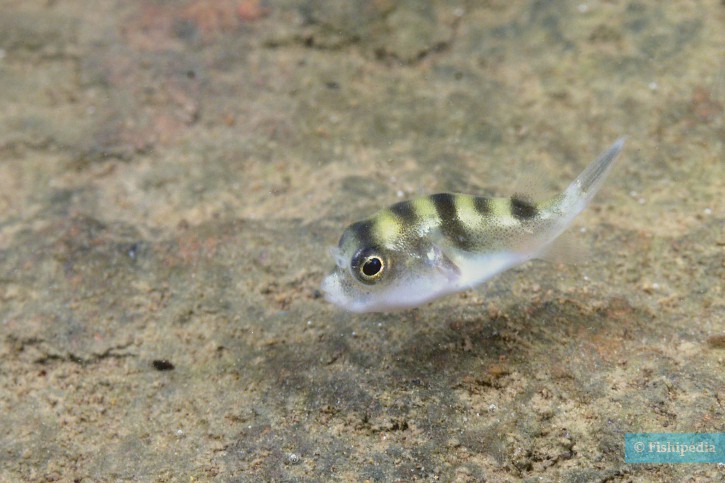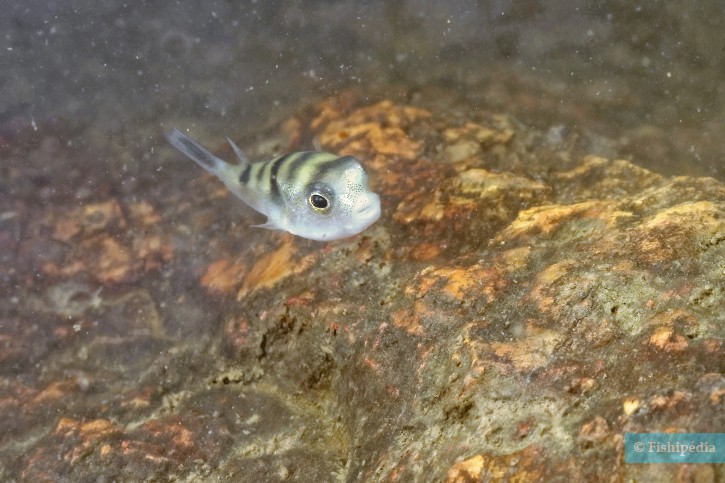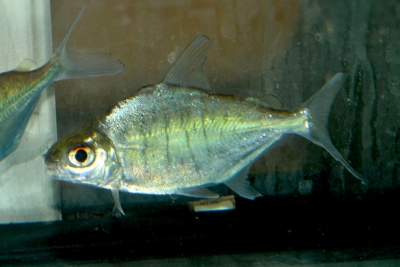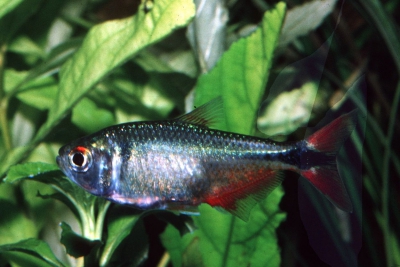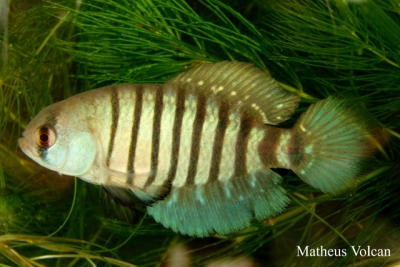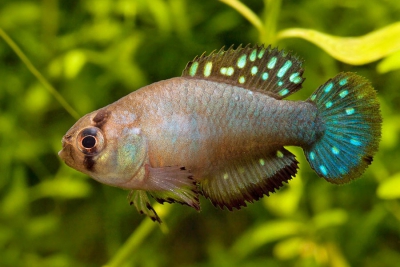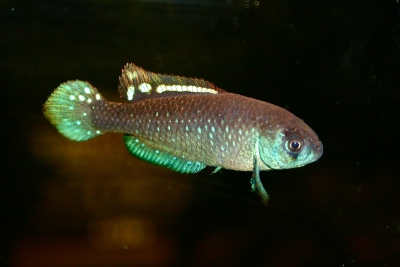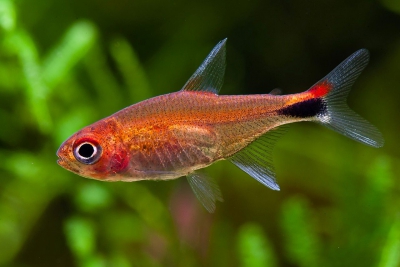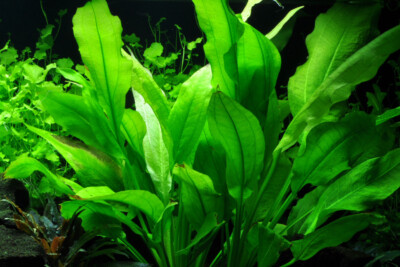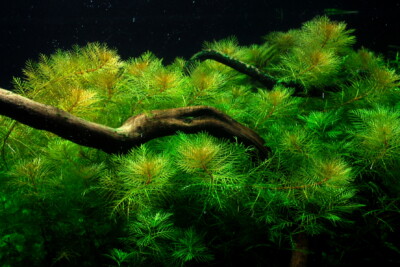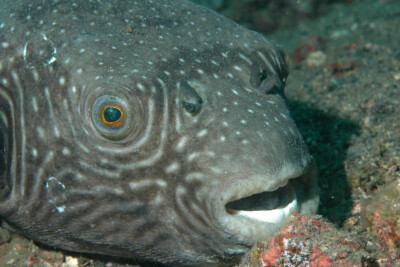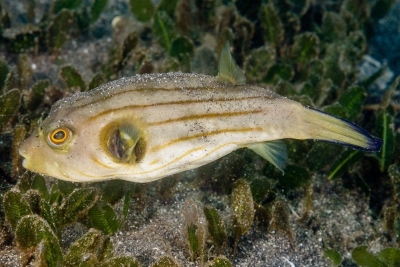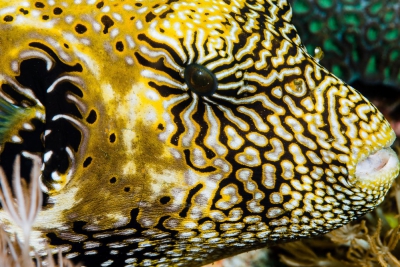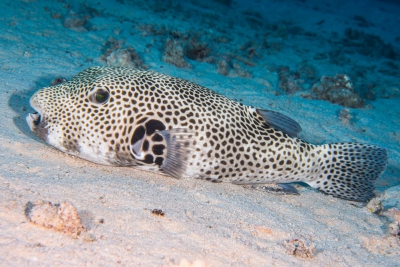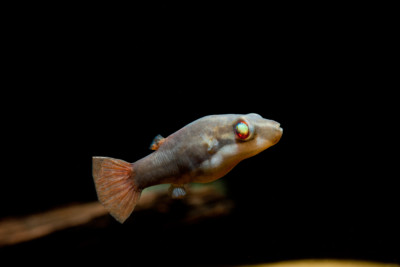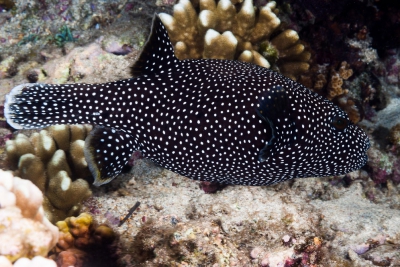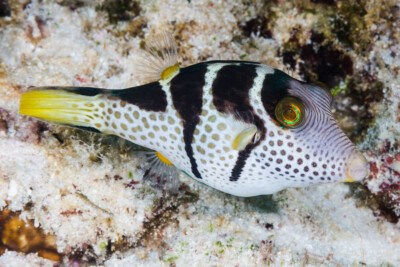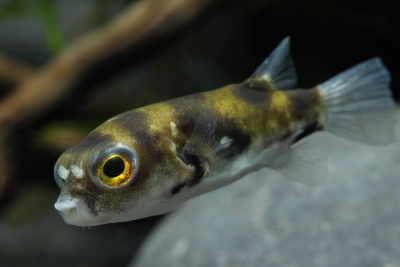banded puffer
| Scientific name | Colomesus psittacus |
|---|---|
| Descriptor | Bloch & Schneider |
| Year of description | 1801 |
| IUCN category (World) | LC |
| Family | Tetraodontidae |
| Genus | Colomesus |
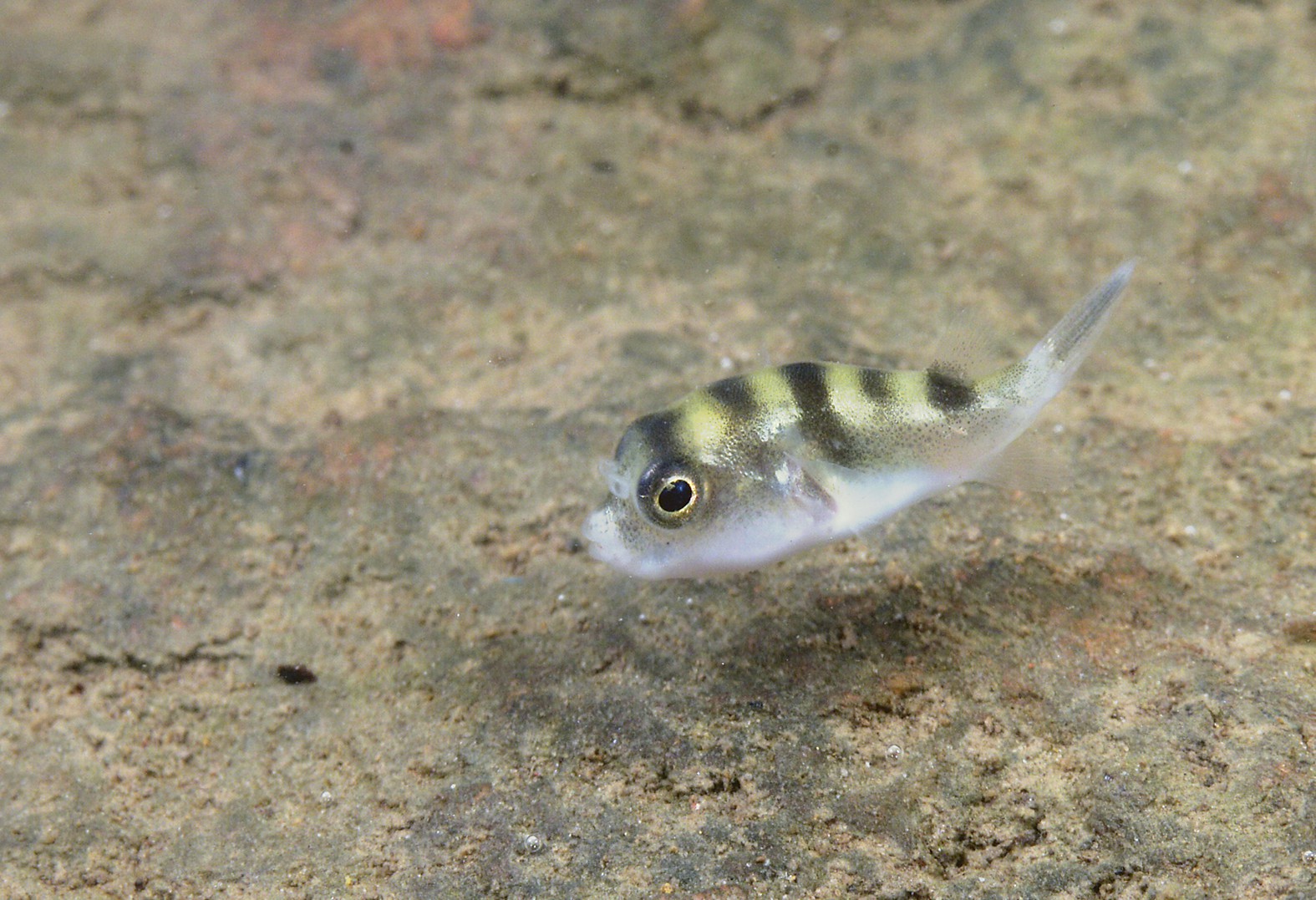

Introduction
Who is it?
Morphology
-
Average size25 cm
-
Maximum size30 cm
-
ShapeBalloon and near
-
Average size25 cm
-
Maximum size30 cm
-
ShapeBalloon and near
How to recognize This fish ?
This species belongs to the group of pufferfish. These fish are nicknamed like this because they have the ability to inflate themselves when they feel threatened.
To achieve this inflation, they swallow water and fill their stomach to more than double their volume. This is made possible by their stretchy skin. This subterfuge makes them look much more impressive to their predators. They are also much more complicated to swallow. This change in shape becomes a disadvantage for these fish that, once inflated, can hardly move.
Like all pufferfish, Colomesus psittacus has a protruding jaw with several rows of teeth. These teeth have the particularity of growing at a fast rate as they are constantly worn down by the shells of snails that it breaks to feed.
As an adult, it can reach up to 30cm, making it a particularly large pufferfish among its family.
Sexual dimorphism
Dimorphism not specified.
Behaviour & Life cycle
-
dietcarnivorous
-
Sociabilitysolitary
-
territorialNo
-
Way of livingdiurnal
The banded puffer lives solitarily as an adult. It specializes in hunting snails, breaking their shells with its powerful teeth. It is highly toxic and inflates itself to scare away predators.
Reproduction
-
Reproductionovipare qui pond en eau libre
The banded puffer is an oviparous fish that lays eggs in open water.
Harmless species
This species does not represent any particular threats to humans when encountered in its natural environment.
Origin and distribution
Geographic distribution & Conservation
This species is found from the Guyanas, through northern Venezuela to the Lesser Antilles and the Bahamas. It is present in the estuaries of the Orinoco and Amazon rivers. Juveniles are sometimes confused with Colomesus asellus.
Conservation status of populations (IUCN)
What is its habitat?
Natural environment characteristics
-
Temperature23 - 26 °C
-
pH (acidity)6.5 - 7.5
-
gh (hardness)5 - 12
-
FlowMedium
Biotope presentation
The species particularly favors calm brackish waters near the coast. It is a highly toxic fish that has little to fear from predators, despite its sometimes clumsy swimming.
Main recommendations for fishkeeping
Deontology
In order to preserve wildlife, if you acquire this animal, it must not be released into the wild. See also, the Fishipedia charter.
Fishipedia supports the practice of responsible and environmentally friendly aquarium keeping. We encourage maintenance if it is motivated by a desire to understand the biological functioning of living things and if it is done with respect for animal life.
We believe that aquaristics is an opening to the discovery of aquatic environments, especially freshwater, and that this knowledge is necessary to better protect and respect these environments. Logically, we refute the compulsive purchase of animals that would not find a sufficient and / or adapted place in the host aquarium.
Our recommendationsThese tips apply to adult species from breeding. With regards to water conditions, wild species or close relatives must be kept under the same conditions as in their area of origin.
-
Min volume500 liters
-
Population min1
-
Temperature23 - 26 °C
-
pH (acidity)6.5 - 7.5
CharacteristicsThe characteristics below apply for adult species. They correspond to an average of cases, validated in maintenance condition.
-
Difficulty breedingThe farming difficulty is relative. It depends on experiments already carried out with similar species. First, it takes into consideration the robustness of the species, the ease of recreation of a favorable environment and the general behaviour with the other inhabitants of the aquarium.very difficult
-
Robustnesstolerant
-
Behaviourslightly aggressive
-
Availabilityrare
General reminders
It is strongly advised to read the complete dedicated file and to get information on the feedbacks of maintenance of the envisaged animal, this to avoid any potential conflict whose end result is generally the death of the individual (or the other inhabitants). It is important not to overload your aquarium to limit pollution. This will make maintenance easier.
In nature, animals are subject to weather conditions and live in waters with variable characteristics. The recommendations offered by our team for aquarium maintenance are a guidance and cannot be assimilated to scientific datas.
General reminder on maintenance datas
Le démarrage d'un aquarium est une partie primordiale pour l'équilibre et le bien-être des poissons. Lorsque l'on met en eau un aquarium, l'eau passe naturellement par un cycle biologique : le cycle de l'azote. Celui-ci dure environ trois semaines. Tous les 2 jours, nous vous conseillons de tester votre eau jusqu'à ce que le taux de nitrite soit à zéro pendant plusieurs jours d'affilée.
Pour accélérer ce cycle, vous pouvez utiliser un activateur de bactéries comme JBL Denitrol. Cette solution riche en bactéries vivantes et enzymes permet une mise en place rapide du cycle de l'azote. Les poissons peuvent alors être introduits plus rapidement.
Il est important de tester l'eau de son aquarium régulièrement pour maintenir un environnement sain pour les poissons et les autres habitants. Les tests d'eau permettent de mesurer les niveaux de différents paramètres tels que le pH, la dureté totale, ainsi que les taux de nitrates, de nitrites et d'ammoniaque.
Pour réaliser ces tests, vous pouvez utiliser des produits d'analyse spécialisés tels que JBL ProScan qui permet de réaliser un diagnostic de l'eau directement via un smartphone. Il existe également des coffrets de tests plus classiques de bandelettes, comme JBL PROAQUATEST.
En cas d’usage de l’eau du robinet, vous pouvez utiliser un conditionneur d’eau de type Biotopol de JBL pour éliminer les substances nocives comme le chlore, le cuivre, le plomb et le zinc. Les conditionneurs d'eau garantissent une meilleure santé aux poissons et une meilleure croissance des plantes.
Chlorine and chloramine are dangerous for the health of animals. Used to disinfect water, these agents are present in significant quantities in tap water. We recommend using an anti-chlorine agent every time you change the water. In addition to chlorine, treatments and medicines sold for aquarium use sometimes contain dangerous heavy metals in high doses.
Specific needs for the banded puffer
The banded puffer is a species which lives naturally at a temperature between 23 °C and 26 °C. For proper maintenance, the temperature should never exceed the 29°C for long periods. Nitrate levels should remain below 50mg/L. To keep the water clean and unpolluted, plan on changing 20% to 30% of the water volume each month.
The banded puffer is a species whose maintenance is rather reserved for informed aquarists . It can only be successfully carried out by carrying out a minimum of documentation work. Special husbandry conditions can easily lead to the death of the species or other animals.
This species is very rare in the aquarium trade. Instead, it is maintained by knowledgeable aquarists who own and breed individuals from wild origin strains. If you want to get this species, we advise you to contact specialized clubs. }Specimens from long time breeding are a bit easier to breed but you have to respect the particular water parameters.
Cohabitation & Environment
In a community aquarium context, this species should be kept in a minimum volume of 500 liters.
The species enjoys a particularly vegetation-rich environment. The addition of plants will provide many useful hiding places for resting. These areas are also conducive to possible breeding in the aquarium.
Tips for feeding
The banded puffer is carnivorous.
This species can eat dry food (flakes, pellets), fresh food and frozen food. To avoid deficiencies, it is recommended to vary the types of food.
You should not overfeed your residents to avoid polluting the water. For most species, it is better to feed a few small portions each day rather than one large meal.
Reproduction protocol
-
Maintenance difficultyvery hard
-
egg-laying protectionNo
Hybridization risks
In general, it is advised not to mix several species of the same genus or different varieties of the same species, to avoid the risks of hybridization.
These animals might interest you
These plants might interest you
Plants play a crucial role in aquariums, both for their ability to filter water by absorbing excess nutrients and for their aesthetic contribution. They provide fish with natural hiding places, can serve as breeding sites, and generally help maintain the overall balance and optimal conditions of the aquarium. The selection presented here includes species from the same regions as the species described on this page, although they do not necessarily come from its exact natural biotope.
To go further
Sources & Contributions
Participation & Validation
The Fishipedia team and specialist contributors are committed to providing high-quality content. However, although the information comes from scientific sources or testimonials from specialists, the cards may contain inaccuracies.

Benoit Chartrer
Translation
Translation done with the valuable contribution of our translators, who make this information available to a wider audience. We sincerely thank them for their commitment.
Scientific partners
Tags
Species of the same family
Same genus
